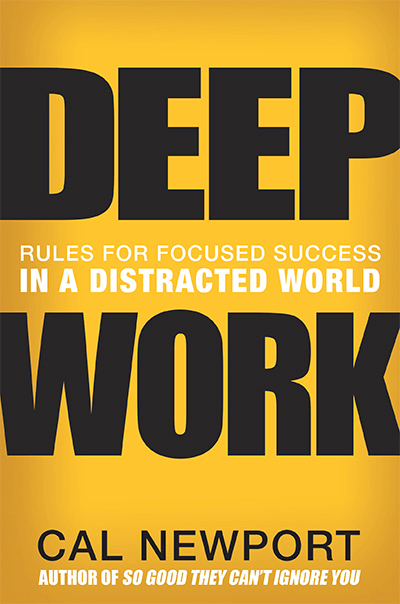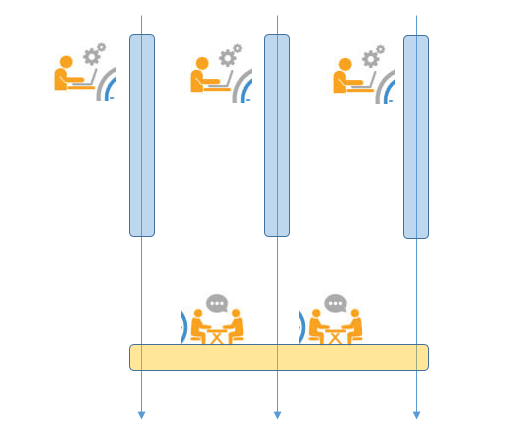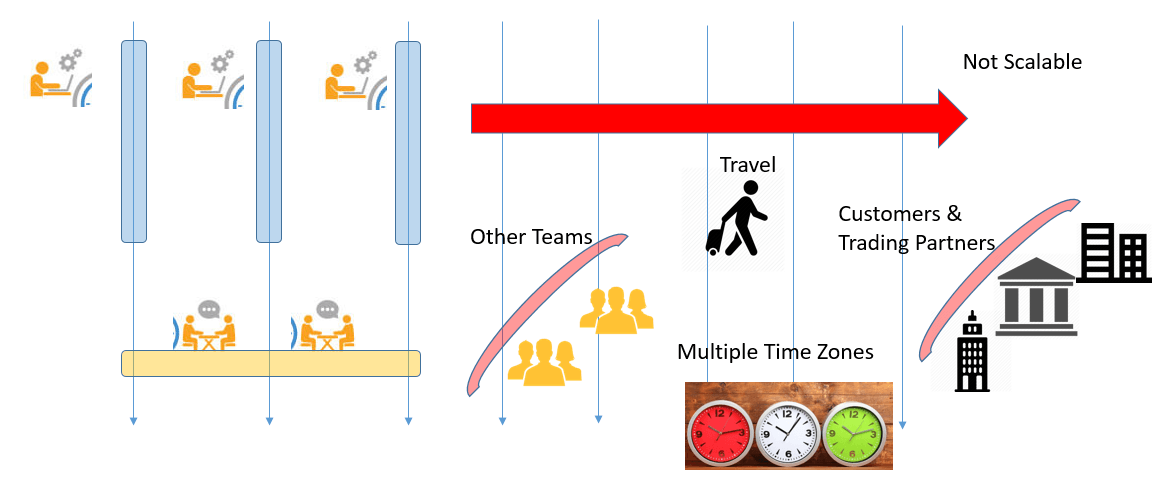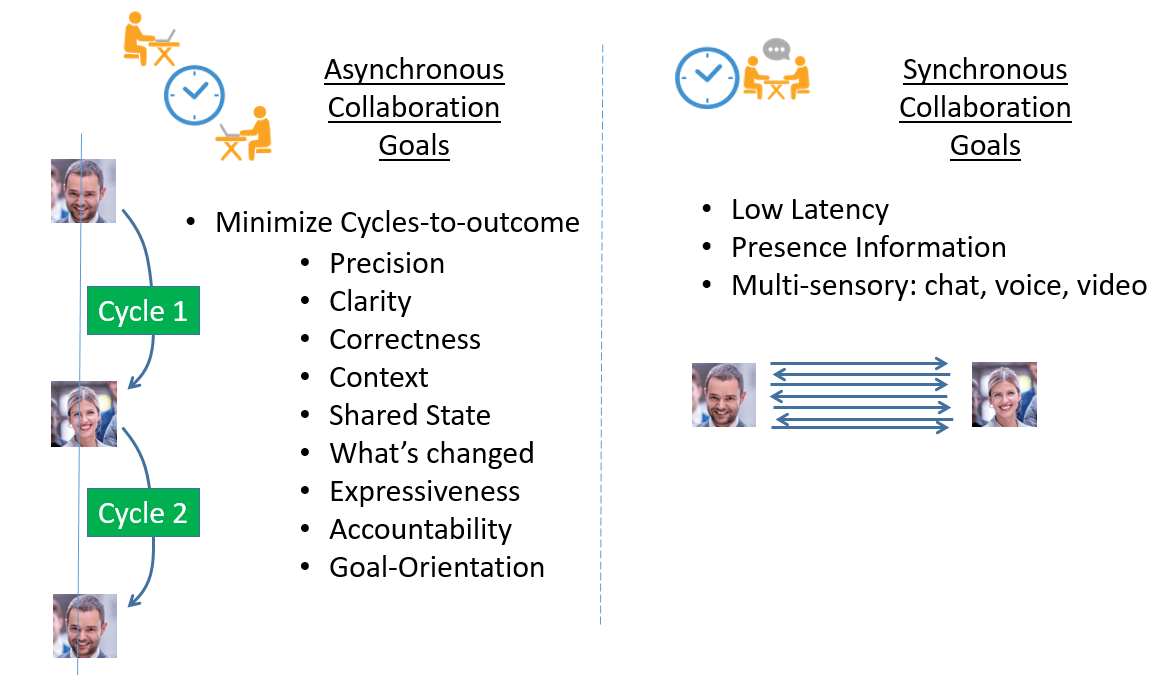How Deep Collaboration Enables Deep Work for Teams
It’s been known for some time now that distraction is one of the biggest killers of productivity. In his recent book “Deep Work: Rules for Focused Success in a Distracted World“, Cal Newport takes this insight to the next level.
He goes beyond diagnosing the problem, to proposing a remedy. His remedy is Deep Work. Deep Work is the idea that one needs to carve out time where one can focus in an undistracted manner on cognitively intensive activities. This kind of sustained focus is not only key to thriving in an increasingly competitive economy, it is also intrinsically satisfying.
The author describes it best (emphasis added):
“One of the most valuable skills in our economy is becoming increasingly rare. If you master this skill, you’ll achieve extraordinary results.
Deep work is the ability to focus without distraction on a cognitively demanding task. It’s a skill that allows you to quickly master complicated information and produce better results in less time. Deep work will make you better at what you do and provide the sense of true fulfillment that comes from craftsmanship. In short, deep work is like a super power in our increasingly competitive twenty-first century economy. And yet, most people have lost the ability to go deep-spending their days instead in a frantic blur of e-mail and social media, not even realizing there’s a better way”
The key to deep work is “focus without distraction“. Cal calls the opposite of Deep Work, Shallow Work.
“Shallow Work: Noncognitively demanding, logistical-style tasks, often performed while distracted. These efforts tend to not create much new value in the world and are easy to replicate” (emphasis added)
There are several trends that are causing Shallow Work to overwhelm Deep Work. These are
- The trend towards Open Office Plans.
- The trend towards Real-time collaboration.
- The expectation of immediate response.
- Interrupting coworkers with requests. (Great for the requester, not so great for the responder)
- Meeting overuse
- Busyness as a visible proxy for Productivity
Numerous studies have shown that this “always available” model is not only less productive, but also takes us away from “Flow” and “Happiness”. Deep Work, in contrast move us towards Flow, where one tends to maximize creativity and feel an inherent enjoyment of the task.
Cal’s Deep Work, defines several solutions to Deep Work. These are:
- Monastic: Go away for days, weeks or months.
- Rhythmic: Perform Deep Work on a repeating schedule.
- Bimodal: Switch back and forth between Deep and Shallow Work
- Journalistic: Opportunistically perform Deep Work when possible
The problem with all of these solutions is that they work individually, but are impractical (as described) in a team setting. The basic problem with all of these approaches in a team setting is that unless the entire team’s Deep Work schedule is synchronized (only possible with the Rhythmic approach), the team as a whole is left with no time for real-time collaboration which is also incredibly valuable.
The figure below illustrates a Synchronized Approach for team Deep Work.
Synchronized Deep Work
While this approach can work with very small teams that are extremely cohesive, it becomes increasingly infeasible as teams gets larger. The figure below shows some of the reasons why Deep Work synchronization does not scale.
Deep Work Synchronization Does Not Scale
In the absence of Deep Work Synchronization, team members are left with two approaches
- Synchronized Shallow Work (i.e. Meetings)
- Asynchronous Work
The problem with Synchronized Shallow Work (i.e. Meetings) as the sole remedy is that as team workload increases, meetings tend to dominate everyone’s schedule. Worse, they “cut up” team members schedules in such a way as to leave no time for Deep Work.
Based on the above it can be seen that Asynchronous work is a critical component of any team’s repertoire. Deep Collaboration is collaboration that optimizes Asynchronous collaboration.
Let’s compare the goals of Asynchronous Collaboration vs. Synchronous Collaboration.
Let’s look in more detail at two of the most important enablers of Deep Collaboration, viz. Expressiveness and Effective Catch-up & Comprehension and their implications:
Expressiveness
In order to reduce cycles-to-outcome, it is critical that “senders” be able to express themselves in a variety of appropriate (asynchronous) ways. The better they can express themselves, the less likelihood of receivers being unclear and as a consequence responding asking for clarification.
So, any Deep Collaboration system must support multiple basic asynchronous flows for maximal expressiveness. Some of these Basic Asynchronous Flows are listed below. Others are possible as well.
1) Basic (Asynchronous) Discussions
2) Task Management for Accountability
3) (Asynchronous) Content/File Collaboration
4) Lightweight Process Management
Effective and Efficient Catch-up and Comprehension
From the “receiver’s” perspective, it is critical they have a clear comprehension of the current state of the collaboration. Partly this is made more likely by the expressiveness of Deep Collaboration. However, expressiveness is not sufficient. There are other critical elements of that are required for effective catch-up and Comprehension.
1) Unambiguous Current State
If we look at the Basic Async Flows listed earlier, we can see that with the exception of “Basic Asynchronous Discussions”, the others are all stateful. It is critical, that to avoid misunderstandings (such as acting on non-latest state) that this state is unambiguous. Current state (of Tasks, Content, Files, Workflows etc.) is made unambiguous via sequential versioning of state.
2) Meaningful Current State
The current state must be meaningful. In the absence of the state being meaningful, the “receiver” could easily get confused, leading to clarification cycles, dramatically reducing the effectiveness of asynchronous collaboration.
Now, what could cause state to not be meaningful? If we put aside the “sender” making a mistake, the most common cause of lack of meaningfulness, is that the collaboration system allows information to be dribbled out. With this approach (common to “real-time” collaboration”), the “receiver” may “see” incomplete (and hence possibly meaningless or misleading) information.
The “receiver” may also then act on incomplete, meaningless or misleading information, further compounding the problem and thus requiring many compensating clarification cycles.
In order to avoid this problem, Deep Collaboration must provide the ability for the “sender” to release information in sender-controlled meaningful information portions or changesets.
3) Meaningful Change Tracking
Even if the collaboration state is unambiguous and meaningful, that is typically not sufficient for Deep Collaboration. This is because once the state has reached a certain size it becomes impractical for the “receiver” to fully process the entire state from scratch.
Thus meaningful change tracking becomes critical. This allows the “receiver” to comprehend the current state by only processing the meaningful changes.
Historically, because this capability was neither easy to use nor widely applicable it had been reserved only for the most critical asynchronous collaborations such as Contract Collaboration using (say) Microsoft Word Change Tracking.
In Deep Collaboration, change tracking is necessary as fundamental element and must be available by default and without any effort on the part of the user.
4) A Sequence of Meaningful Intermediate States
Because different “receivers” will be “caught up” to different levels in the collaboration (it’s asynchronous after all), a corollary of supporting Meaningful Change Tracking, is that Deep Collaboration needs to support a sequence of Meaningful States.
5) Sender Commentary synchronized with Meaningful Information Parcels
Earlier we saw how Deep Collaboration needs to enable senders to release information in Meaningful Information portions.
These Meaningful Information Parcels may contain various state changes (eg. Tasks assigned/added, Files Created/Updated/Deleted, Content Created/Updated/Deleted, Checklists Advanced, Forms Filled Out, Workflows advanced etc.). Even though collectively these state changes may be meaningful, (eg. a User Updated a File in a certain way and closed a Task based on that), the overall meaning may not be self-evident from the individual state changes.
And so, it is critical that Deep Collaboration allows senders to attach commentary about the meaningful state changes as part of the Meaningful Information Changeset. This commentary can greatly ease the catch-up burden on the receiver and convey the sender’s intent as well.
6) Dual View
As we can see from the above points, Deep Collaboration gives “receivers” a dual view of the collaboration. Both a “latest” view as well as a sequential changeset history. In metaphorical terms, in Deep Collaboration, the Journey is as Important as the Destination.
7) An Inbox with Meaningful Changesets
So, far we have been discussing Catch-up for a single Deep Collaboration Entity. Since a user will be collaborating on many entities/topics/threads/projects/processes simultaneously, there is a need in Deep Collaboration for a user to have an Inbox with Meaningful Changesets.
Additionally, an Inbox metaphor necessitates a powerful ability to prioritize and triage.
Changeset-Oriented Collaboration as the basis for Deep Collaboration
The requirements of expressiveness (supporting multiple basic async flows) and catch-up/comprehension of Deep Collaboration can be met with a collaboration technique called Changeset-Oriented Collaboration.
In Changeset-Oriented Collaboration, the main collaboration “entity” is made up of one or more basic async flows. The “sender” releases meaningful changesets across one or more these basic async flows along with synchronized change commentary.
Alternatives for Deep Collaboration
Let’s briefly consider some alternatives to Deep Collaboration that are available today.
Email is probably the closest as it has some necessary elements such as an Inbox and user-controlled release of information. However it does not represent unambiguous latest state at all. Furthermore it lacks expressiveness in terms of supporting tasks, processes, content/file collaboration etc.
Other conventional collaboration tools such as File collaboration, project management and business process management tools do support unambiguous current state. However, they lack user-release of information (especially in their real-time incarnations) and do no in general support meaningful change tracking and synchronized commentary.
A loose coupling of all of these tools cannot marry the Inbox and user-controlled-releases aspects of email with the unambiguous-current-state of the other tools. And of course none of these tools individually or in combination support Changeset-Oriented Collaboration.
It is clear that if we are to meet all of the goals of optimized asynchronous collaboration we need to rethink it from the ground up.
Deep Collaboration is asynchronous collaboration done right. It meets all of the goals of asynchronous collaboration as described above.
It is built on the foundation of Changeset-Oriented Collaboration.
It massively improves upon critical asynchronous metrics including cycles-to-outcome, asynchronous decision throughput, and inbox size compared to the alternatives.
By massively optimizing asynchronous collaboration, Deep Collaboration provides the vital bridge between Synchronous Collaboration and Deep Work especially in team settings. Thus it makes Deep Work possible, providing a massive boost to team productivity, creativity and satisfaction.
Deep Work, Deep Collaboration and Synchronous Collaboration together form three key pillars of team productivity.







